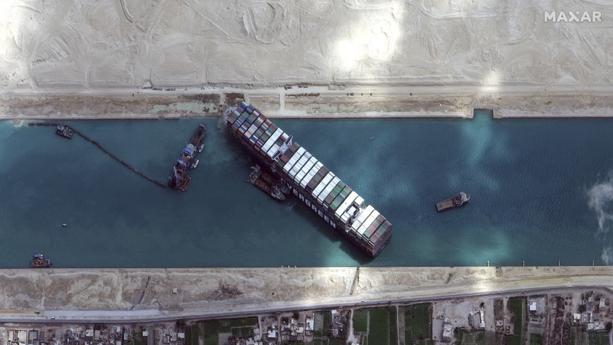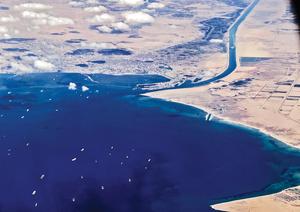 (SONG CHEN / CHINA DAILY)
(SONG CHEN / CHINA DAILY)
Consumer goods deliveries worldwide were delayed after a huge container vessel ran aground in the Suez Canal last month, blocking the vital trade artery.
Although the busy waterway has been cleared, the incident triggered debate over the construction of ever-larger ships, expanded shipping itineraries and China’s role in global trade flows.
The line of hundreds of vessels waiting to pass through the canal was finally cleared on April 3, 11 days after the Ever Given ran aground.
The 400-meter vessel became stuck on March 23, some 115 kilometers north of the southern point of the waterway. The canal handles about 12 percent of global seaborne trade.
After nearly a week of relentless efforts, the Ever Given was freed on March 29, but it took nearly another week to clear the line of 422 vessels waiting to pass through the canal.
Even before the incident, global trade had been under pressure due to the pandemic, with a high number of shipping cancellations, container shortages and slower handling speeds at ports.
Experts said the incident further dented recovery efforts for global trade and supply chains, highlighting the fragility of worldwide commerce flows and the need to diversify transportation itineraries.
Yu Zhanfu, partner and vice-president for China at consultancy Roland Berger, said, “The Suez Canal blockage highlighted the necessity to have a plan B (for trade and supply chains).
“This could be a backup plan for emergency situations, so that business operations or logistics are not completely cut off by incidents such as this.”
Some 1.2 billion metric tons of cargo pass through the Suez Canal annually, while 1.9 million barrels of oil are shipped through the waterway each day, according to the Suez Canal Authority and Lloyd’s List Intelligence. A total of 18,829 ships used the canal last year — an average of more than 50 vessels per day.
Lin Guolong, director of Shanghai Maritime University’s Logistics Research Center, said about 60 percent of Chinese vessels heading from their home country to Europe and Africa pass through the 193-km canal to avoid the much longer trip around the southern tip of Africa.
Qi Qi, an associate professor at Guangzhou Civil Aviation College, said the ship’s grounding was a wakeup call for Chinese companies to diversify their logistics solutions.
“Relying too heavily on a single transportation route is not advisable, as occurrences such as this prove,” Qi said.
However, there are alternatives for transporting goods between China and Europe.
 This satellite image released by Maxar Technologies shows the MV Ever Given container ship in the Suez Canal on the morning of March 28, 2021. (MAXAR TECHNOLOGIES / AFP)
This satellite image released by Maxar Technologies shows the MV Ever Given container ship in the Suez Canal on the morning of March 28, 2021. (MAXAR TECHNOLOGIES / AFP)
The China-Europe freight train service, launched by China, has acted as a carrier for the Belt and Road Initiative in boosting trade exchanges between more than 60 domestic cities and major European countries.
Liu Mingming, deputy director of the administration department at Yiwu Timex Industrial Investment Co, which operates Europe-bound freight trains in Yiwu, Zhejiang province, said the service is reasonably priced and highly efficient. Since the pandemic emerged, it has become an important alternative to transporting goods by sea or air.
The company, a wholly owned subsidiary of YXE Group, operates YXE container trains.
Zhou Shihao, founder and CEO of YQNLink, a global intelligent logistics platform based in Shanghai, said rail freight charges between China and Europe are usually 50 percent higher than those for sea freight. Charges have remained stable during the pandemic.
Rail services are preferred by customers willing to pay more to transport high-value-added products with improved efficiency, rather than sending them by sea, Zhou said.
When the Suez Canal was blocked and it was not known when it would be cleared, daily inquiries for China-Europe freight trains more than tripled on YQNLink, Zhou added.
Freight forwarder THI Group (Shanghai) saw China-Europe freight train orders placed while the waterway was blocked rise between 30 and 40 percent compared with the previous week.
Kong Weidong, executive vice-president of the company’s railway business unit, said, “Due to limited storage space, our clients have to make reservations 20 days in advance.
“It typically takes between 30 and 40 days for goods to arrive in northern Europe by sea, but about half this time by freight trains,” Zhou from YQNLink said. He added that such trains operating between China and Europe are the “most cost-effective transportation solution”.
Nationwide, freight trains made 12,400 journeys and transported 1.14 million twenty-foot equivalent units, or TEU, of cargo last year, marking year-on-year rises of 50 percent and 56 percent, respectively.
Last year may not have been a good one for most industries, but this was not the case for road transportation services between Europe and China.
Since the pandemic emerged, the global logistics industry has faced huge challenges. Marine freight services have been delayed due to local prevention measures, air cargo capacities have shrunk because of the large number of international flights canceled, and there is insufficient capacity on China-Europe freight trains to cope with this situation.
Dilxat Mamat, chief operating officer at Alblas Transport (Xinjiang), said, “Against such a backdrop, truck transportation is emerging as a new option for China-Europe trade.”
 An aerial view of ships waiting to enter the canal last month. (MAHMOUD KHALED / AFP)
An aerial view of ships waiting to enter the canal last month. (MAHMOUD KHALED / AFP)
Experts said that compared with other modes of transportation, moving goods by road is efficient, cost-effective and offers flexibility.
Umberto de Pretto, secretary-general of the International Road Transport Union, based in Geneva, Switzerland, said a rising number of European consumers are shopping online during the pandemic. There has been consistent growth in the highly efficient, flexible, door-to-door transportation solution, along with rising demand for Sino-Europe cross-border e-commerce.
IRU manages Transports Internationaux Routiers operations, or TIR, the only global customs transit system for moving goods across international borders. TIR has United Nations’ authorization.
China joined the UN TIR Convention in 2016. The convention is now applicable in ports across the Chinese mainland.
De Pretto said the convention means that goods can be sent door-to-door by truck, saving about 10 days compared with rail services, or the equivalent of shipping by air with door-to-door delivery. The cost is also at least 50 percent lower than that for air transportation, he added.
Dilxat Mamat said that in the past year, Alblas Transport (Xinjiang) Co’s business revenue rose more than tenfold, due largely to orders for high-value-added electronic products, along with cross-border e-commerce. He believes that demand will continue to grow strongly this year.
Zhou Yan, chief representative of IRU’s East and Southeast Asia representative office, believes road transportation across Eurasia has a bright future.
This is due to the huge potential for trade between China and Europe, the unique strengths of road transportation, the growing recognition it has received during the pandemic, and the consistent optimization of China’s “international road transportation environment”, Zhou Yan said.
Yu, from Roland Berger, said the Suez Canal blockage showed that China has sufficient backup options for such incidents, allowing its transportation services to continue in the event of an emergency and ensuring at least partial operation of supply chains.
Qi, from Guangzhou Civil Aviation College, said: “Each mode of transportation is unique and they can complement each other.”
Experts suggested reducing reliance on the Suez Canal to ship goods between China and Europe.
After the canal was blocked last month, Maersk, the shipping and logistics business of AP Moller-Maersk Group, redirected some of its vessels around the Cape of Good Hope in South Africa.
Lin, from Shanghai Maritime University, said this meant it took an extra three to five days for goods to arrive.
In addition to longer voyages, there are safety issues such as high winds, heavy seas and piracy, Zhou Shihao said.
Chen Zhuo, a senior analyst at China Merchants Securities, said, “Using the Suez Canal saves time, but the waterway also has its weaknesses.”
Lin suggested the Arctic route could be a good alternative, adding, “For voyages between Shanghai and Hamburg, Germany, it could save about 6,400 km, compared with using the conventional route.”
Shorter shipping times mean reduced transportation costs, along with lower energy consumption and carbon emissions, Lin added.
Yu said, “Not only would the Arctic route greatly reduce journey time, it would include Northeast China and play a significant role in the economic revitalization of China’s old industrial bases.”
In recent decades, the Suez Canal Authority has worked to expand the waterway to cater to larger vessels.
However, Lin said that with extremely large vessels setting records for shipping efficiency and cost-saving, safety has taken a back seat.
“I think the pursuit of larger vessels is getting out of control and is risking safety, which should be the priority,” Lin said.
To achieve high efficiency, companies are keeping their inventories at a low level, Chen said, adding that “it is important to strike a balance between low inventories and stable supply chains”.


